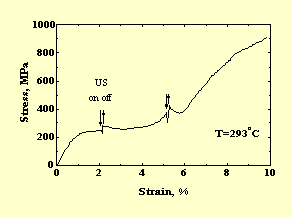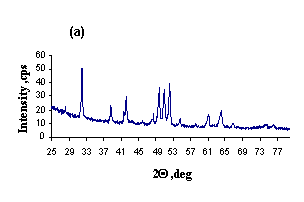

Fig.1. The stress-strain diagrams NiTi-wire under impulse action US
STRESSES IN THE SHAPE MEMORY ALLOYS
Teodor Breczko1 and Vasiliy Rubanick Jr.2
1Olsztyn University of Agriculture and
Technology, Oczapowski 11, 10-736 Olsztyn, Poland,
e-mail: tbrek@moskit.art.olsztyn.pl
2 Institute of Technical Acoustics, Lazo
107-114, 210033 Vitebsk, Belarus
Keywords: stress, ultrasound, shape
memory, nitinol,
The display of shape memory effect (SME) is connected extremely with the temperature factor and mechanical stress [1]. Heating can be done indirectly as well as directly, to say, by conveying electrical current through an alloy possessing SME. Experimental papers have recently been published which show that stress and temperature are stimuli equal in equivalence for initiating martensitic reactions, i.e. the same mechanical effects can be achieved by means of both stress and temperature.
In the light of the stated the use of ultrasonic vibrations for the initiation of SME is of interest. Ultrasound vibration (US) cause under certain conditions not only heating of the material but also occurrence in it of rather significant mechanical stresses alternating in sign.
In the present work the experimental research data of the influence of US on NiTi plastic properties of a wire at a stretching about one axis are presented. To study the influence of US on NiTi-wire plastic deformation in the process of stretching about one axis the latter was subjected to a stretching with constant speed 3.2*10-5 m/s, ultrasonic frequency 22 kHz. The amplitude of the waveguide end ultrasonic displacement was kept up to 5mm, which provided the deformation amplitude in the wire e<10-4. The dependence specific electroresistance, deflection on temperature for the initial annealed NiTi-wire specimens is shown in. Imposing of US on a sample, being exposed to a stretching in the martensite phase results in the yield limit reduction. US being switched off, stress increases. Significant hardening of a material in comparison with a stretching without US was not observed. However at excitation of US in a wire being when T ~ Ms yield stress sharply grows, and then on US being switched off it falls down to the initial or to the stress of a lower value than that preceding the switch-on of the US. In our experiments such phenomenon was observed at numerous switch-on of US down to deformation by about 6%. At a further stretching the US switch-on caused a yield limit reduction (Fig.1). At the moment of US switch-on in the wire under the influence of additional US-stress the temperature transformation of martensite into austenite takes place and it causes a sharp increase of the yield limit. As this condition of austenite is a stable, on disappearence of an additional stress there in the converse transformation A->M. Owing to the fact that US change CT there will be formed more martensite in the material than there was up to a moment of US switch-on. It results in some decrease of yield limit.
The effective action of ultrasound in comparison with traditional ways of heating is probably caused by the fact that US energy is absorbed mainly on the inhomogeneities of crystal structure (dislocations, grain boundaries, point defects and so on), while the absorbed thermal energy is distributed uniformly on the whole volume. As a result US promote initiation of phase transformations. The influence of ultrasonic vibrations is known to result in reduction of the yield limit of a material. The latter is essential at processing material by stress.
 |
 |
Fig.1. The stress-strain diagrams NiTi-wire under impulse action US |
|
Such phenomenon was not found out in the other material [2]. It is quite possible that such abnormal behavior of strength properties under the getting of US is caused by the plasticity of transformation. For the benefit of this assumption testifies high plasticity of a wire after the termination of deformation in the limits up to 6%. Probably at the moment of US switch-on conditions for plasticity of transformation are worsened. It is necessary to note that long US action results in sharp increase of stress down to destruction. Probably they're in another explanation to the given phenomenon. One thing is indubitable: the influence of US on the plastic properties of NiTi is not unequivocal as in case of other materials and requires further study.
 |
 |
Fig.2. The XRD patterns of
equiatomic NiTi alloys: (a) -initial state; (b) - after US action
at 290 K (10 sec)
Thus the undertaken research permits to draw a conclusion
about a possibility in principle to insensible phase
transformations in NiTi alloys possessing SME with the help of
US. The mechanism of US influence cannot be connected only with
its thermal action. US permit to change the kinetics of
martensite reactions which opens ample opportunities on SME
management in various alloys.